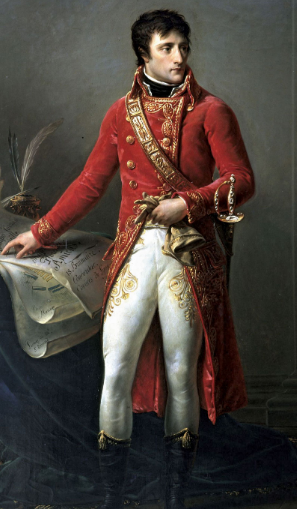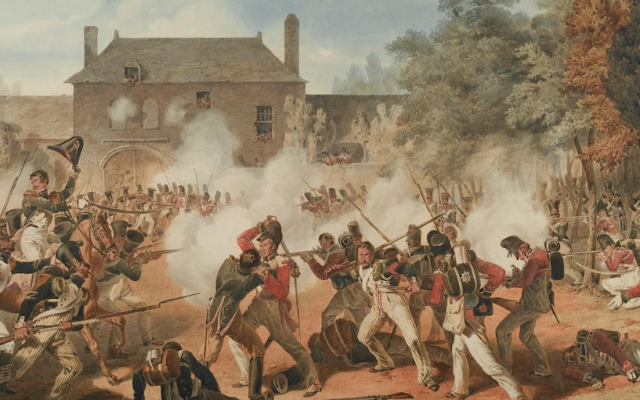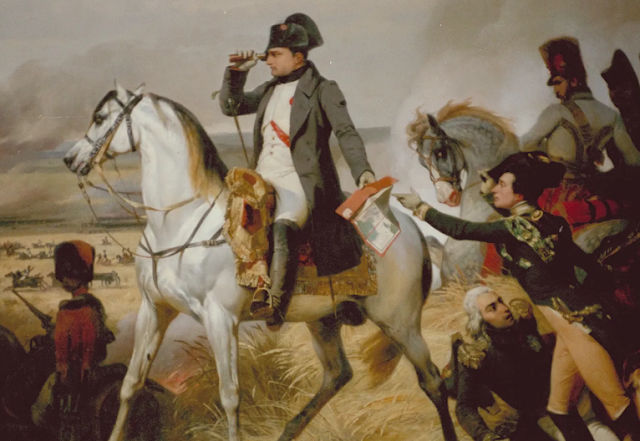Maaveeran Napoleon: Napoleonic Victorious
The history of Europe took a sudden and defining turn in the 1790s. The French Revolution emerged as a critical event of enormous proportions - changing the future of the world through fire and blood. A historic landslide opened a radical new era that changed the lives of many - albeit at a terrible cost. Considered one of the bloodiest pages in history, the French Revolution was the foundation of numerous large-scale conflicts that emerged in its wake. These conflicts lasted from 1803 to 1815 and are collectively known as the Napoleonic Wars. With their vicious nature, their magnitude, and the catastrophic loss of lives that they brought, the Napoleonic Wars showed to the world that a fundamental change of history is always unforgiving and bloody. The late 1700s were a very restless period in France. The so-called “Ancien Régime” (the Old Regime), as the French Monarchy was called at the time, was the leading body in that country, controlling its political and social aspects. It was ruling France for several centuries up to that point, but it was starting to fail in several key aspects.
By the 1780s, this monarchy grew immensely unpopular amongst the common people and was openly hated. At the time, France was one of the largest nations in Europe but was – nevertheless – suffering from a string of debilitating economic difficulties. Interestingly, it was also one of the wealthiest nations on the continent - but that wealth was not for all to enjoy. Most of it was reserved for the nation’s nobility and the sprawling court of the monarchs. France was gripped by instability as its citizens suffered social inequality, high taxes, and a lack of rights. The lowest class was made up of peasants who were rightfully the most displeased. And even the middle class “bourgeoisie,” the traders and craftsmen, were under pressure from the overly high taxes. Such inequality could not endure forever.
The old regime and the nobility were becoming hated more each day and were soon facing the entirety of the French populace as their opponent. The crisis was deepened when France became unable to finance its mounting government debt, resulting in a significant economic depression. Unemployment was widespread, food prices were sky-high, and the discontent amongst the people was evident. King Louis XVI of France and his nobles were now facing a crisis that could not be controlled. In 1789, this crisis finally erupted, signalling the start of the French Revolution. For the next decade, this struggling European nation descended into chaos and bloodshed as the poor people of France took up arms against the monarchy.
By 1792, the Old Regime - the monarchy - was abolished. This ended the many long centuries of nobility and their rule. The First French Republic was declared on the September 22,1792, and in the following year, the ex-King, Louis XVI, was executed on the guillotine. His death marked a truly revolutionary change in Europe’s history, even though it was a change born from chaos. And that was not the only thing that emerged from the whirlwind of revolution:
Napoleon did as well. A native of Corsica, Napoleon Bonaparte was the son of minor Italian nobles. Thanks to his ambitious character, this man managed to swiftly rise through the ranks in the military and eventually became one of the leading figures of the French Revolution.
As a man, he was marked with an insatiable thirst for power. From the devastation of the revolutionary period, Napoleon emerged as a leader, establishing a military dictatorship that aimed to revive France in a new light. This was the birth of democracy and social equality in Europe - a change that required a lot of struggles. In a record-breaking time, Bonaparte accomplished a stunning feat: he placed wounded France back on its feet, solidifying its economy, creating a strong bureaucratic system, and - most importantly - he managed to create a powerful standing army.
Following the revolution, Europe experienced a series of changes that created a complex socio-political picture. New alliances were made between the world’s foremost powers, and tensions rose continually. There was a noticeable change in the power levels of the major states in Europe, and the whole region was critically unstable as relations between them rapidly crumbled. Between 1803 and 1815, new alliances were made almost yearly, and it was common for allies to turn into enemies at a moment’s notice. Far in the east, the mighty giant that was Russia was steadily growing in power, expanding its borders through its conflicts with Turkey and Poland. The venerable Kingdom of Prussia and the Austrian Empire made a powerful alliance, while the United Kingdom and France were locked in an economic stalemate. The stage was being set for a war of massive proportions. Most of these major powers saw Napoleon’s rise to prominence and the subsequent French expansion as a direct threat to the international system and their interests.
Who lost the Napoleonic Wars?
The British, fuelled by their growing lack of control in Europe and alarmed by the threat of Napoleon on their overseas colonies, declared war on France in 1803. Two years after, Russia and Austria created the Third Coalition intending to defeat Napoleon. And in that year, the first serious clashes of the Napoleonic Wars occurred. Napoleon Bonaparte was a military genius. His enemies were quick to discover this fact as they suffered some devastating defeats. In October of 1805, Bonaparte conducted a series of daring manoeuvres that allowed him to trap an entire Austrian army during the Ulm campaign. Soon after, in December, he further proved his skill in strategy during the legendary Battle of Austerlitz when he decisively defeated a larger Russo-Austrian army. This is regarded as one of the most critical battles of the whole war and solidified Napoleon’s reputation as one of the greatest military commanders in history. Even so, 1805 brought a significant setback for the French when they were crushed at the naval Battle of Trafalgar.
Due to inexperienced leadership and poor choice of action, the combined Franco-Spanish fleet was outgunned and decimated by the British under the command of Admiral Lord Nelson. This defeat extinguished Napoleon’s hopes of invading Britain. With the Third Coalition defeated, France continued its rapid growth in power. This led to the forming of the Fourth Coalition - an alliance between Sweden, Saxony, Russia, Prussia, and Britain, and the continuation of the war. But not even this powerful alliance was enough to stop Napoleon. On October 14th, 1806, he utterly crushed the armies of Saxony and Prussia in the Battles of Jena-Auerstedt. Following this victory, France occupied the Kingdom of Prussia. A few months later, in June 1807, the Russians were the next to be stunned. At the bloody Battle of Friedland, Napoleon secured a decisive win, inflicting close to 40,000 casualties on the Russians. These defeats prompted a quick disintegration of the Fourth Coalition and a peace with Napoleon that was never to last. Meanwhile, the French now had to direct their attention to the south.
Napoleonic Victorious
The people of Spain opposed Napoleon’s occupation of their country and soon rose in revolt. This event, known as the “Dos de Mayo” uprising, grew out into the Peninsular War, pushing Britain and Portugal into a bitter conflict against France for the possession of the Iberian Peninsula. That war would last until 1814. The peace that came with the end of the Fourth Coalition was quick to fall through. In 1809 the war in mainland Europe resumed in earnest, with a new - Fifth - coalition formed against Napoleon. Although poorly prepared, this coalition - led by Austria - would soon prove to be a challenge for Napoleon’s reputation. On May 22, 1809, at the Battle of Aspern-Essling, the Austrian Archduke Charles won a stunning victory against Bonaparte. This was Napoleon’s first defeat in over a decade. However, he was quick to recuperate and quickly – in July - won a decisive victory at the Battle of Wagram, which brought an untimely end of the Fifth Coalition. But soon, the tables were turned. Taking a considerable and ambitious risk, Napoleon put everything on the line when he began a massive invasion of Russia in 1812.
At the time, it was one of the most significant invasion forces in military history, ready to subdue the mighty giant that was Imperial Russia. Alas, the French were soon to find out that it was too much to tackle. After several crucial battles, such as those at Smolensk and Borodino, Napoleon reached the capital, Moscow, only to find it abandoned. The ravaging eastern winter soon set in, forcing the French into a long and decimating retreat out of Russia. Napoleon’s army was nearly destroyed, with casualties being unprecedented.
Many historians agree that this was the point where it all went downhill for the French. The once-mighty army of Napoleon halved and severely weakened, his enemies grouped up into the Sixth Coalition with the aim of finally defeating him. They managed his defeat after a bitter campaign and a major victory at Leipzig. By March 1814, Paris also fell, and Napoleon was exiled to the island of Elba. However, he was not to be contained so easily.
In February of 1815, Bonaparte made a daring escape from captivity and once again took control over France, resuming the war. Soon after, the Seventh Coalition was formed against him and managed to land a decisive and final blow to his effort at the famous Battle of Waterloo in June 1815. This time, Napoleon was exiled to the remote island of Saint Helena, where he remained in captivity until his death, six years later.








0 Comments
Chat with InfoWite!